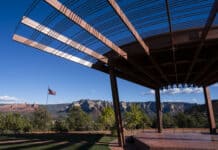Tomorrow, Saturday, July 20, marks the 50th anniversary of the first footsteps on the moon.
Neil A. Armstrong, Michael Collins and Edwin E. “Buzz” Aldrin, Jr. were launched four days earlier on a journey to reach our nearest planetary body, set foot on its surface and then return safely home.
We had stared at the moon for so many generations that the desire to reach it was burned into our bones. The moon illuminated the night for our ancestors and inspired them to dream about the stars. Its regular phases still dictate many lunar calendars used around the globe, its gravity affects Earth’s tides and our bodies’ internal clocks.
Its proximity, with features that can be seen by the naked eye, made us wonder if we could one day reach it and see those features up close.
In 1969, some 600 million humans around the globe watched a grainy telecast of Armstrong and Aldrin walking down a short ladder and leaving their footprints on the surface. My paternal grandfather, a Montana copper miner who had never owned a television, went out and purchased the biggest television he could find so his family and neighbors could watch the landing.
Current theory suggests a Mars-sized planet called Theia struck a primordial, molten Earth 4.5 billion years ago, creating the moon from the debris. When Aldrin and Armstrong returned to Earth with moon rocks and lunar samples, it was the first time our two spheres touched again after billions of years apart.
When Armstrong came to Flagstaff to speak at the dedication of the Discovery Channel Telescope in July 2012, a month before he died in what would be his last public appearance, I was in the audience with photojournalist Tom Hood and about 500 other guests as he discussed the Apollo 11 mission and the progress of science since that historic mission.
It still ranks as the best assignment I’ve ever had as a journalist.
Armstong, like all the other astronauts who walked on the moon, was humble about his achievement. The Apollo missions — the largest peacetime project in our nation’s history — involved the work of more than 400,000 people, from scientists, engineers and technicians to construction workers who helped build the component parts for the rockets, modules and technical equipment, making it hard to develop an ego that one man or even three could succeed alone.
True to form, Armstrong minimized his involvement: He said that the Apollo 11 mission was simply to place some mirrors on the surface of the moon so astronomers here could bounce a laser off the surface and measure the distance to the Earth. Armstrong said he was just a “technician on the project” whose job was to install the mirrors.
In hindsight, the mission to reach the moon was an unmitigated success of science, political will and the determination of hundreds of thousands of people working toward a common goal. A plaque left behind sums up the mission for us all: “We came in peace for all mankind.” But at the time, with myriad problems that could end the flight early or end the mission in failure and leave astronauts dead or drifting to their death with no hope of rescue, the odds were reduced to about 50/50.
Thus, prior to the mission, Apollo 8 astronaut and liaison to the White House, Frank Borman, asked presidential speechwriter Bill Safire to draft a statement for President Richard Nixon to read to the American people and the world should the mission fail.
The speech was secret for 30 years, but is now in the National Archive and is a beautiful, poetic work of human sorrow that the world never had to hear. However, the last line still resonates: “For every human being who looks up at the moon in the nights to come will know that there is some corner of another world that is forever mankind.”
This Saturday, July 20, the time to gaze up and remember that human footprints on that sphere are still untouched, waiting for us to return.
Christopher Fox Graham
Managing Editor
Astronaut Neil Armstrong’s last speech on July 20, 2012, on the 43rd anniversary of the Apollo 11 landing on the moon.



















